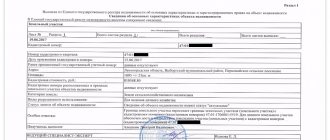Citizens remember, you cannot be left without access (passage and passage) to your site on the basis of Federal Law-221 2.1. The cadastral registration authority makes a decision to suspend the registration of a land plot also in the event that access (passage or passage from public land plots) to the land plot being formed or changed is not ensured, including by establishing an easement.
Even at the stage of brewing conflict, order from the Russian Register
(https://rosreestr.ru/site/)
boundary plan 1).for your site and 2).for the site through which access is provided
.
Cadastral numbers of these plots can be found on the public cadastral map (https://maps.rosreestr.ru/PortalOnline/) The boundary plan must indicate through which lands access (passage and travel) to your plot is carried out : public lands
or indicating cadastral number of the neighboring plot.
An example of such a boundary plan: (ZOP can be privately owned) Please note: 1.
If the land plot being formed (changed) is a public land plot, the section “Information about land plots through which access to the land being created or changed is provided” plots" of the boundary plan is not filled in. (PZP may be privately owned)
Please note:
2. If access to public land is provided through an adjacent land plot, information about providing the resulting (changed) land plots with access to public land by limiting rights rights holders of adjacent land plots are included in the boundary plan on the basis of relevant contracts or agreements concluded between the owners of land plots, or persons to whom such land plots are provided on the right of lifelong inheritable ownership or on the right of permanent (perpetual) use (clause 64 of the Order of the Ministry of Economic Development of the Russian Federation No. 412 dated November 24, 2008).
Please note:
3. In the column “Characteristics of the part” of the sections of the text part of the boundary plan, the words are entered: “Part of the land plot was formed in order to provide land plot No. (its cadastral number or designation is indicated) with access to lands (land plots) for public use. It should be written there: “Information about encumbrances and restrictions: access is provided to a plot with cadastral number XXXXX.” If there are no encumbrances on the neighboring plot, then this is a cadastral engineer’s mistake that needs to be corrected. An error was made at the stage of dividing the plots. There should be no such entry (for the area through which access is provided): no restrictions or encumbrances have been established.
Federal Law-221 Requirements for a land surveying project (approved by order of the Ministry of Economic Development of the Russian Federation dated August 3, 2011 N 388) Registered with the Ministry of Justice of the Russian Federation on September 19, 2011 Registration N 21825 (has the force of law) 3. The land surveying project is approved: 2) decision of the owner of the land share or land shares. 6. The land surveying project consists of text and graphic parts, which are divided into sections. In cases provided for by the Requirements, an appendix is included in the Land Survey Project. 7. The text part of the Land Survey Project includes the following sections: 6) information on ensuring access to the newly formed or changed land plots. Please note: First, a land surveying project is prepared and approved by the owner of the site. The project contains information about providing access to newly created or modified land plots. By approving this project, the owner undertakes to provide access to the newly created areas. This encumbrance becomes a permanent characteristic for the site through which access is provided and no longer depends on the owner.
More details in the attached files
Citizens remember, you cannot be left without access (passage and travel) to your site. I would like to clarify - free.
What is the width of the access road to a plot of land if it is surrounded on three sides by other plots of land? At first I was told that the width of the access road was 5 meters, then 4 meters. So what is the actual width of the road to the land plot and by what standards is it determined?
Expert answer
A description of the rights of land owners will be incomplete if we do not touch upon the issue of the owner’s right of access to his own plot. Such a right is not directly enshrined in law. The right of access to one's own plot exists only if there is actually an approach, driveway or driveway to the existing plot of land. In other situations, this issue is resolved by establishing an easement. The existing driveway and passage to the land plot are its integral part. In accordance with the Regulations on the procedure for establishing land use boundaries in the development of cities and other settlements, approved by Decree of the Government of the Russian Federation of February 2, 1996 N 105, the boundaries of a land plot include all objects included in the real estate, entrances and passages to them (p . 4). According to Part 4 of Art. 41 of the Town Planning Code of the Russian Federation, a mandatory condition for dividing a land plot into several plots is the presence of entrances and approaches to each formed land plot. In accordance with the Methodological Recommendations for conducting land management during the formation of new and streamlining existing land management objects, approved by Roszemkadastr on February 17, 2003, the land plot is necessarily provided with access - in the form of a passage (at least 1 m wide) or a driveway (at least 3 m wide). .5 m). A plot of land on which there are permanent buildings or the right to erect them is provided with passage. Access to the site is provided both from public lands and from the territory of other land plots by establishing a private easement.
An easement is a right limited to someone else's real estate. Not all citizens are aware of such a concept as, but everyone has used the fruits of its application.
For example, light and energy enter the house through power lines, heat and water come through a modern water supply system, and high-quality communications thanks to a large number of tower stations. All such transmission installations, one way or another, come into contact with the right of limited use of land objects, that is, an easement.
The concept of easement is legally enshrined in Article 23 of the Land Code of Russia. According to this article, an easement is the right to limited use of someone else's land plot.
The owner/possessor of a land plot has the right to own, use and dispose of the land, but at the same time he undertakes to provide free access to the object specified in the title documentation, as well as to holders of easements, that is, persons who have the right to limited use of someone else’s land plot.
The right of the owner of real estate (land) to claim from the owner of a neighboring land plot the establishment of rights of limited use is determined by Article 274 of the Civil Code of the Russian Federation.
An easement will always be associated with a specific property.
This could be a building, structure, or land. An easement is not an independent object or mortgage. The right of limited use cannot be transferred to other persons who are not the owners of the real estate object for whom such a right was established.
In accordance with Article 275 of the Civil Code of the Russian Federation, during the transfer of rights to land with the presence of an easement, obligations under (restrictions) are transferred to the new owner.
The requirement to establish an easement can be transferred to federal, regional, and municipal authorities, depending on which body is the owner of the plot, but the provision of an easement cannot be demanded from the tenants of the land plot.
Who can demand the establishment of an easement?
A private easement is established on a voluntary basis. The interested party and the owner of the land plot enter into an agreement. The agreement specifies all the details and conditions of restrictions on land ownership.
In turn, a public easement does not require the consent of the owner of the land plot. The decision to establish an easement is made at public hearings.

Thus, the owner of land or other real estate has the right to demand. In addition, the requirements for establishing an easement can be made by owners of land plots on or.
Citizens or organizations that own real estate on the basis of other rights (for example,) do not have the right to demand the establishment of an easement on the road. However, their right to pass, drive through someone else’s land plot and other needs can be protected by presenting requirements for the absence of interference in the use of real estate belonging to them.
The procedure for establishing a private land easement
A private easement is established in the interests of a specific individual or legal entity.
So, a private easement can be established:
- By agreement of the parties, the agreement must be in writing
- By the tribunal's decision
An agreement or a court decision to establish a land easement is the basis for mandatory registration of a land easement in Rosreestr.
Therefore, upon reaching an agreement, or upon the entry into force of a court decision, the interested party applies to Rosreestr or the MFC to register a private land easement.
HEALTHY:
Duties of the parties
The parties to the passage to the land plot are the “authorized person” (the owner of the easement) and directly the “obligated person” - the one who has this easement established.
The obligated party must not interfere with the authorized person’s use of his limited right (easement) within the scope of such right on the land plot.
In turn, the authorized person is obliged to pay the obligated party for the easement in a timely manner and in the amount specified in the contract. can be demanded both from a private individual and from the government body that made the decision to establish an easement.
The payment must be proportionate to the benefit that the obligated person could have received if his land plot had not been encumbered by the easement.
The interested party also undertakes to use the right granted to him to use someone else's land plot for the purposes and on the conditions that were established and secured by a bilateral agreement (agreement) on easement.
Sample agreement on providing access to a land plot
Home » Land » Sample agreement on providing access to a land plot

The establishment of an easement facilitates the exploitation of another site without obstacles on the part of its owner, but not the entire territory of the allotment, but only a certain part intended to satisfy one’s own needs. Undoubtedly, the existence of an easement on the plot will prevent the owner of the plot from fully using it in his own interests. For example, if a public road is laid through a site, then unauthorized persons have the right to use it.
In some cases, the plots may contain property of other owners, for example, an electrical substation, which leads to restrictions on the construction of buildings near this object of property rights. Since an easement establishes restrictions on the use of one’s own or the state’s plot, it may be endowed with various legal grounds.
Easement established for access to the site

Often a situation arises when it is only possible to get to your own land if you cross someone else’s (neighboring) land. If such a situation arises, you can enter into an agreement (agreement) with the owner of your neighbor’s land, which implies the establishment of a private easement.
However, if the territory for passage is required not only by one citizen, but by a whole group of people, the authorities can establish a public easement for passage and passage in order to ensure the interests of local residents. Such a decision will be made at public hearings and will not be agreed upon with the owner of the encumbered plot.
Required documents
The necessary documentation for registering an easement, both public and private, is listed in Article 28 of the Law “On Registration of Rights to Real Estate and Transactions with It”:

- Statement from the person in whose favor the easement will be established;
- Identification documents of the applicant (if this is an individual), constituent documents, power of attorney, extract from the Unified State Register of Legal Entities (if this is a legal entity);
- Receipt for payment of state duty;
- An easement agreement (drawn up in simple written form), relevant decisions of federal, regional, municipal self-government bodies or a court order;
- If only part of the plot is encumbered, then the application must be accompanied by a cadastral plan of the land plot with the scope of the easement outlined on it, or an extract from the cadastral service with similar information. If the establishment of an easement is required for the entire territory of the site, then such documents do not need to be provided.
How to correctly draw up an agreement on the division of a land plot between owners
The agreement for the real division of a land plot is drawn up in simple written form between all its owners.
If real estate belongs to several persons on the basis of joint or common shared ownership, then its division is impossible without drawing up the specified document.
However, before drawing up this agreement, the following steps must first be carried out.
Owners must determine:
- how the land plot will be divided, namely into what shares and shares;
- boundaries of newly created plots.
- the legality of such a division, due to the fact that not every property is subject to division.
What areas can be divided?
Basically, restrictions on division are related to the intended purpose of the site or its form of ownership.
Thus, during division, each newly created plot must have exactly the purpose that corresponded to the original purpose of the original plot.
For example, if the property was primarily used for agricultural needs, then the newly formed parts should be used for such purposes. Similar rules will apply when dividing sites for urban development.
The procedure for establishing an easement
Private
In order to encumber real estate with an easement, the interested person (the legal owner of the land plot) must make an offer to the owner of the encumbered real estate to enter into an agreement to establish an easement.
Structure of a contract (agreement) on a private easement:
- Name of the agreement, information about the parties to the agreement;
- Information about the property in respect of which the easement is established;
- Goals and objectives of the easement limitation;
- The scope of the easement, that is, its boundaries, a certain territory on the site; The amount of payment for the use of someone else’s site, as well as the procedure for making such payment;
- Other conditions, rights and obligations of the parties under the agreement.
In accordance with the terms of the easement agreement, the owner of the encumbered real estate undertakes, for a certain fee, to provide such real estate for the needs of the right holder of neighboring land or real estate.
Under this type of easement, the owner of the encumbered plot can be legally obliged to:
- Organize free movement around the site;
- Ensure the construction and laying of socially important utilities (communication lines, power lines, gas supply, water supply, etc.);
- Create conditions for carrying out work to create and maintain land reclamation and water supply systems in proper condition;
- Other needs that cannot be satisfied without establishing an easement.
The easement will be established from the moment, which will allow the agreement to come into force accordingly.
Public
A public easement arises from legislative decisions of federal, regional or municipal authorities. Decisions are made, first of all, to implement the interests of the state, local administration or local population.
List of purposes for which the administration may deem necessary:

- It is necessary to periodically move around the site;
- Carry out repair work and install various utilities and transport infrastructure facilities;
- Install special signs and provide access to them;
- Organize water supply;
- Drive away livestock;
- Preserve the historically formed traditions of haymaking or grazing;
- Organize hunting and fishing in a closed reservoir located on the site;
- Collect wild plants;
- Conduct research work;
- Provide access to the coast.
The main thing is the payment of a private easement. However, a public easement can also be established on a paid basis, provided that the owner of the land, along with the emergence of an encumbrance, has serious difficulties. For example, part of the land plot became unusable for crop production, or economic facilities had to be destroyed or moved, etc.
Procedure for establishing payment

The amount of payment for an easement depends on the nature and intensity of use of the land plot by the person in whose interests it was established.
In addition to the fee for the right of passage or passage through someone else’s land plot, depending on certain circumstances, the fee may include the expenses of the owner of the encumbered object to create optimal conditions for the implementation of the easement right to use someone else’s real estate, including the costs of ensuring security and access control, bringing the road surface into proper technical condition and other costs.
In relation to a public easement, a proportionate payment can be demanded only if the establishment of an easement will lead to significant difficulties in the use of the land plot, which is enshrined in paragraph 7 of Article 23 of the Land Code of the Russian Federation.
The easement fee is calculated as the total amount of losses caused to the owner of the encumbered land plot or other property. In this case, the following indicators are added up:

- Amount of actual damage. It is calculated without taking into account the actual damage caused to the owner of land or other real estate due to the early termination of obligations to third parties;
- Lost profits. It is calculated without taking into account lost profits caused to the owner of land or other real estate due to the early termination of obligations to 3 parties;
- Losses. It is calculated without taking into account losses caused to the owner of land or other real estate due to the early termination of obligations to 3 parties.
These and other features of the easement fee are established by the Methodological Recommendations for assessing proportionate easement fees, approved by the Federal Land Cadastre Service dated March 17, 2004.
- one-time payment, when payment is made once and in full for the entire term of the easement agreement;
- periodic, when payment is made repeatedly in certain shares throughout the entire period for which the agreement on the validity of the easement is established.
The method of payment is determined directly by the easement agreement, a court decision or a regulatory legal act of state, regional, or municipal authorities. The parties can also determine the amount of the fee through agreement.
In accordance with the Civil and Land Codes, the amount of payment may be changed during the term of the easement restriction.
This can be due to many reasons:

- the circumstances according to which the parties followed during the conclusion of the easement agreement have changed significantly;
- restrictions on the rights of the owner of land encumbered by an easement have increased or decreased at the end of a specific period after its establishment;
- the parties came to a general agreement to change the amount of the proportionate fee for the easement (private easement);
- the scope of the easement has increased or decreased;
- a state authority or local government body adopted a regulatory legal act that changed the act by which the easement was established in relation to the amount of value (public easement);
- the court made a decision to change the value of a private or public easement by adjusting the easement agreement or a regulatory legal act of the administration.
Thus, the amount of payment for the easement must be proportionate to the benefit that the owner of the encumbered plot could receive if no restrictions were imposed on the land.
Can they refuse, how and when can I challenge the refusal?

The parties may also have various disagreements regarding any clause of the agreement. If such situations arise, the dispute over the establishment of an easement may be referred to the court for resolution. In the future, the easement for the land plot or other real estate will be registered in the Unified State Register of Enterprises on the basis of a court decision.
When filing a claim in court, it is necessary to correctly draw up a petition for the establishment of an easement.
For example, the owner of a land plot along which power lines are installed filed a claim in court against the owner of communications demanding to conclude an easement agreement.
The Federal Court recognized the plaintiff's claims as legal due to the presence of real facts of restrictions on the use of the land plot.
However, the claim was rejected, since the legislation does not contain rules on the basis of which the owner of communications can be forced to enter into an easement agreement.
In the statement of claim, the owner of the land plot must make a request not to conclude an easement agreement, but to remove obstacles to the use of the plot. It is this formulation that will be legally correct and only in this case the owner of power lines will be forced to enter into an easement agreement.
Thus, when filing a claim for the establishment of an easement in court, it is necessary to provide sufficiently serious grounds and evidence
that the establishment of an easement is really necessary. In addition, the law must have rules based on which, in precise wording, one can protect one’s own rights.
How to eliminate the ban on access to a land plot in SNT?
If the passage is blocked, you must immediately contact the police department to record this circumstance and resolve the issue of initiating a criminal case against the chairman of the partnership for arbitrariness.
The issue of removing obstacles to travel can also be resolved through civil proceedings.
As stated in paragraphs 45–46 of the resolution of the Plenum of the Supreme Court of the Russian Federation and the Plenum of the Supreme Arbitration Court of the Russian Federation dated April 29, 2010 No. 10/22 “On some issues arising in judicial practice when resolving disputes related to the protection of property rights and other property rights”, in force of Art. 304, 305 of the Civil Code of the Russian Federation, a claim to eliminate violations of rights not related to deprivation of possession is subject to satisfaction if the plaintiff proves that he is the owner or a person in possession of the property on the basis provided by law or contract, and that by the actions of the defendant, not related to deprivation of possession, his right of ownership or legal possession is violated.
Such a claim must also be satisfied in the case where the plaintiff proves that there is a real threat of violation of his property rights or legal possession by the defendant.
A claim to eliminate violations of rights not related to deprivation of possession must be satisfied regardless of whether the defendant commits actions (inactions) that violate the plaintiff’s right on his own or someone else’s land plot or other real estate property.
Thus, you can file a lawsuit not only when your passage to the site has already been blocked, but also when you are persistently warned about this.
Grounds for cancellation or termination of an easement for access to a site
As a rule, an easement agreement is concluded for an indefinite period, but it is possible to conclude an agreement for a certain period. As soon as the period specified in the contract expires, the right of limited use will cease to apply.
The reasons for this may be:

- The grounds that initiated the establishment of the easement ceased to exist (Article 276 of the Civil Code of the Russian Federation);
- The impossibility of using the site due to the encumbrance that has appeared has been proven in court (Article 276 of the Civil Code of the Russian Federation);
- The owner of a land plot has the right to demand from the state authority or local administration that established the easement, the purchase of such a plot, compensation for losses incurred, or the provision of another equivalent plot of land;
- Physical liquidation of the site;
- Withdrawal of a land plot from civil circulation;
- If the owner of an encumbered property becomes the owner of such an encumbrance, that is, an easement;
- The normative act establishing the easement has ceased to be in effect.







